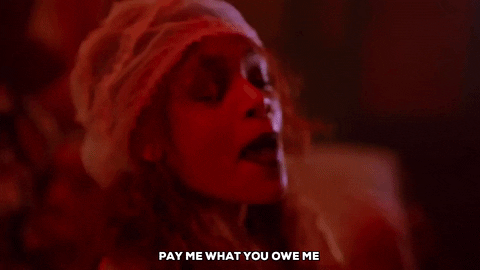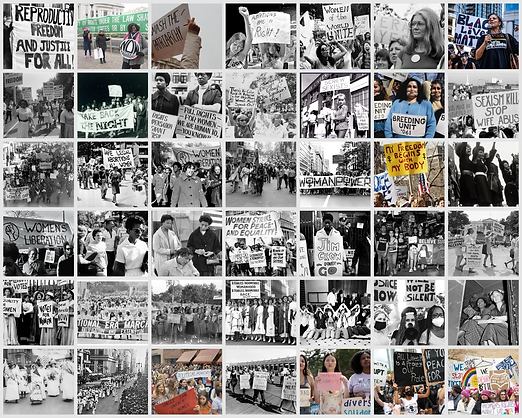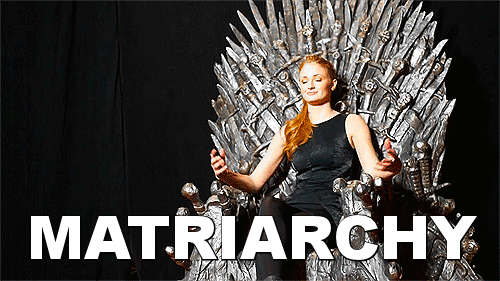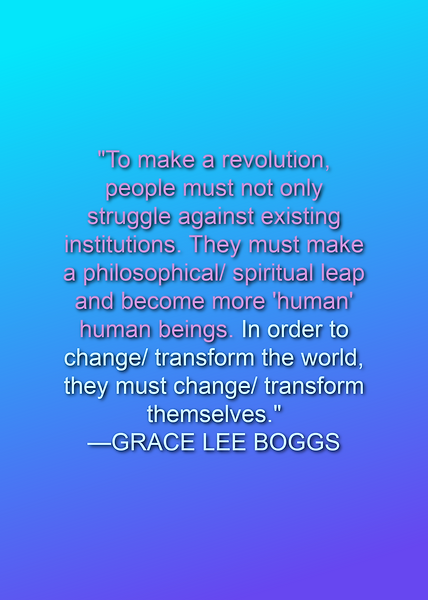

The Trouble With The Patriarchy
The patriarchy's influence extends across many aspects of modern life, contributing to disparities in education, employment opportunities, and income between genders. It also plays a role in normalizing gender-based violence and control over women's reproductive rights.
What is patriarchy?
Derived from the Greek word patriarkhēs, patriarchy literally means "the rule of the father" and is used to refer to a social system where men control a disproportionately large share of social, economic, political and religious power, and inheritance usually passes down the male line.
Defining patriarchy, renowned American sociologist Allan Johnson wrote: "Patriarchy does not refer to any man or collection of men, but to a kind of society in which men and women participate ... A society is patriarchal to the degree that it promotes male privilege by being male-dominated, male-identified, and male-centered. It is also organized around an obsession with control and involves as one of its key aspects the oppression of women."
What are the characteristics of a patriarchal society?
No two patriarchal societies will look exactly the same as cultures and norms are shaped by different factors, such as geography, language, and religion -- and also, because the demands and strides made by feminist movements all over the world are not identical. However, the main characteristic of a patriarchal society is one where men hold more power and authority which subsequently leads to male privilege.
Deeply ingrained biases see men hold most positions of leadership and control resources in both the public and private spheres, while women play a secondary role and are seen as weaker and better suited to domestic labor. As such, a woman's place in a patriarchal society is primarily to be homemakers, procreators or caregivers.
This male dominance perpetuates beliefs and practices (cultural norms) that -- whether consciously or unconsciously -- favor men over women, and these beliefs are not just held by men, but by the majority of the people in that society, whatever their gender.
Recent data from the United Nations Development Program revealed in June that gender biases against women "remain entrenched," finding that "almost 9 out of 10 men and women worldwide still hold such biases today." The organization's Gender Social Norms Index report found that "half of people worldwide still believe men make better political leaders than women, and more than 40 percent believe men make better business executives than women."
In many parts of the world, patriarchal norms mean girls get little or no education, may be married off young, have little or no control over their bodies (whether through access to contraception or abortions) or household income, and will have less digital access than boys.
Even when educational attainment is comparable or girls are doing better in school, patriarchal expectations then shape career trajectories, with women underrepresented in STEM and overrepresented in nursing, for example. Patriarchies are also characterized by unequal pay for the same work; less research on conditions that disproportionately affect some genders more than others (e.g. endometriosis or migraines); a sense of entitlement to sex and pleasure by those who embody more masculine genders; the existence of period poverty, which can affect all who menstruate, and the pink tax -- where consumer goods targeted at women are more expensive; unequal burdens of care; women becoming invisible in older age and stereotypes about menopause; and the prevalence and acceptance of violence committed by men: domestic abuse, sexual harassment and femicide.
Is patriarchy another term for gender inequality?
Gender inequality -- the unequal treatment of someone based solely on their gender -- is an outcome of patriarchal societies but the terms do not mean the same thing.
Is the US a patriarchy?
Despite strides towards sex equality that have been gaining momentum for more than a century, the US remains a patriarchal society.
To date, for example, no woman has ever been US president so the ultimate power as commander-in-chief has always rested with a man.
Data shows that the US lags behind many of its allies around the world when it comes to paid parental leave, maternal healthcare, adolescent fertility rates, and, increasingly, reproductive rights. It also has a persistent gender pay gap, with women earning on average 82 cents to every dollar earned by a man in 2022, according to a Pew Research Center analysis. The data highlights that this gap has barely shifted in 20 years, and is worse for Indigenous, Asian, Latin and Black women.
Progress towards gender equality is neither linear, nor guaranteed. Gains in abortion access have been lost in the past year (with the repeal of Roe v. Wade), and other gains could also be lost as there is no provision in the US Constitution that explicitly protects against discrimination on the basis of sex. The Equal Rights Amendment (ERA), first introduced in Congress in 1923, was never ratified by enough states, though there have been recent efforts to revive it.
Are all societies patriarchal and have they always been?
No. Nor have they always been.
Writing for the BBC, British science journalist Angela Saini explains that "the further we dive into prehistory, the more varied forms of social organization we see." Referencing archeological data from Çatalhöyük in present-day Turkey, described as one of the oldest cities in the world, Saini writes that this was "a settlement in which gender made little difference to how people lived."
But there are also such societies in the contemporary world. Previous research has identified at least 160 matrilineal populations that exist today. These are societies in which lineage is passed down from the mother. This doesn't, however, mean that men are discriminated against in matriarchies. Saini writes: "Often in matrilineal communities, power and influence are shared between women and men. In matrilineal Asante communities in Ghana, leadership is divided between the queen mother and a male chief, who she helps to select."
So aside from Barbieland, what other societies are matriarchies?
Here are just a few of the matriarchal societies known to exist around the world:
The Minangkabau are the world's largest known matriarchal society, comprising millions of people living on the island of Sumatra in Indonesia. They are matrilineal, tracing descent and inheritance through the female line.
The Bribri are among the world's oldest surviving matrilineal communities. This indigenous group mainly lives in the mountainous Talamanca region of Costa Rica and in 2015, it was estimated that there were 11,500 people in this area, with a smaller population in Panama, but their culture is said to be under threat.
There are also the Mosuo in China, the Khasi in India, the Himba in Angola and Namibia and many more. But even social orders don't exist in a binary choice between patriarchies and matriarchies. Of the 1291 populations defined in the 2019 study, 590 were patrilineal. Aside from matriarchies as detailed above, the study also identified five other ways societies decide lineage.
s patriarchy good for men?
Yes and no. While not evenly accorded to all males, being assigned male at birth in a patriarchal society comes with privileges. But it also comes with expectations, and it is these expectations -- that a "manly man" is heterosexual, always strong, shows little emotion, is the provider not the caregiver, dominates over others, must always be in control -- that have led to what is popularly referred to as toxic masculinity.
These ideals are not without consequence, certainly for women (the fact that marital rape is not a crime in many countries, and only became one in all US states in 1993, is just one example) but also for men: studies have explored -- and shown -- a connection between patriarchy and higher mortality rates in men.
In her 2004 book, The Will to Change: Men, Masculinity and Love, Black feminist author bell hooks wrote: "The first act of violence that patriarchy demands of males is not violence toward women. Instead, patriarchy demands of all males that they engage in acts of psychic self-mutilation, that they kill off the emotional parts of themselves."
Can a patriarchy be dismantled?
Any system created by people can be changed by people.
The patriarchy is a social system that was designed by men to favor men. It has been adopted throughout the ages through learned behavior and cultural norms that put men on top. To dismantle this ideal, we have to challenge the entrenched biases against women.
Sounds simple, but there is much work to do. In the face of "sexual and reproductive rights being rolled back" and "women's rights ... being abused, threatened, and violated around the world," UN Secretary General António Guterres said in March that gender equality seemed to be "300 years away."
Listing various areas of inequality, Guterres was explicit about their causes: "Centuries of patriarchy, discrimination and harmful stereotypes have created a huge gender gap in science and technology," before adding: "Let's be clear: Global frameworks are not working for the world's women and girls. They need to change."
There are many strategies that can lead to the change Guterres is calling for, from efforts to change cultural norms, to access to education for girls, women's economic empowerment and institutional reform. But chief among them is also funding and support for women's rights organizations.
In a column for CNN, President of the Democracy Alliance Pamela Shifman wrote: "In order to reverse the mounting damage being done every day to women's and LGBTQ+ rights, feminist movements need more resources. They also need the freedom to respond to new threats and opportunities and to boldly innovate. The threats, in their source and nature, are always changing and we need feminist organizations that are resilient and able to change too. Now is the time to fund those organizations into being."
Source:
What is patriarchy? What does it mean and why is everyone talking about it?
By Eliza Anyangwe and Melissa Mahtani, CNN

The above story is part of CNN's As Equals, CNN's ongoing series on gender inequality. To Find out more about it click the link below!
The masculine and feminine energies don’t fight, they dance.
And when they are equally valued, they build off of one another. There is balance, engagement, and elevation.
When women reclaim their feminine spirituality, it doesn’t just change her life for the better, it elevates everyone around her.
Sue Monk Kidd writes that, “when a woman breaks out of boxes that have limited her, when she sets her plucky self free and begins to nourish and enrich herself, her relationships are nourished and enriched as well.”
When we reclaim our femininity as equally valuable, we are able to bring this energy into our communities and churches.
So how do we do that?
We rewrite the stories we’ve been told about ourselves.
Sue says, “For thousands of years the ‘feminine’ has been deeply associated with the body, flesh, sensuality, earth, and nature, while the ‘masculine’ has been associated with spirit, heaven, and transcendence over nature.”
Our path is to rewrite the story that body, flesh, sensuality, earth, and nature are secondary to spirit, heaven, and transcendence over nature—they don’t fight, they dance.
After Jesus’ death, he appeared to his disciples and showed them his scars because the scars and experiences of our bodies stay with us even after death.
When were we convinced that perfection in the afterlife meant that we were completely disassociated with our bodies and experiences in this life?
Our bodies are holy.
They hold all of our experiences, including the spiritual ones.
They are temples, houses of the Divine.
Along the way, we’ve been convinced that our experience of body, flesh, sensuality, earth, and nature are somehow disconnected from God…
But we know from the scriptures that these experiences are a part of a healthy spirituality that invites people of every gender into a deeper intimacy with their creator.
Yes, we have thousands of years of patriarchal interests and conditioning to understand and untangle, especially those perpetuated by the churches we love.
But we’re doing it together, and we have a lot of men joining us too.
Theologian Elizabeth A. Johnson summarizes the patriarchal influence in the church this way:
“For most of [the church’s] history women have been subordinated in theological theory and ecclesial practice at every turn.
Until very recently they have been consistently defined as mentally, morally and physically inferior to men, created only partially in the image of God, even a degrading symbol of evil.
Women’s sexuality has been derided as unclean and its use governed by norms laid down by men…
They are called to honor a male savior sent by a male God whose legitimate representatives can only be male, all of which places their persons precisely as female in a peripheral role.
Their femaleness is judged to be not suitable as metaphor for speech about God. In a word, women occupy a marginal place in the official life of the church.”
But the tides are changing.
Institutions are people, and people are imperfect. We have grace for this.
At the same time, we recognize that the feminine experience is still devalued and dismissed at work, in churches, and in social settings.
What would it look like for this to shift?
What stories do we need to rewrite about femininity?
How can we begin balancing masculine and feminine energies in ourselves and our churches?
Here’s to a feminine life not on the periphery
Written By: Alycia Owens

The masculine and feminine energies aren't supposed to fight, constrict each other or suffocate each other, they should, support each other, learn from one another, lift each other up, and dance.
And when they are equally valued, they build off of one another.
Then, there is balance, engagement, and elevation.
But under the current system, and for many many years the patriarchy has ruled supreme.
It is my vision that if women's voices were the ones in charge, the nurturing of the feminine nature could heal the what's been broken, soothe the pain that's been inflicted, and balance would be restored and maybe, just maybe then, the divine masculine and divine feminine could truly represent the light in its fullness to the world.
Do I want to petrify the patriarchy lol, no, maybe freeze them for a bit, till we can repair damages done. But if the patriarchy continues it's course as is, without our assistance, they will indeed bring the tower down themselves, on top of us all.
So yes, I wish to bring the tower of the patriarchy down, on our terms, for a gentler landing, with much less destruction left in it's path than if they are left to their own devices.

Whether using the magickal power of intention:
To Overturn The Patriachy/Oligarchy/And The Fascist Regime
or practical activism and direct actions, we CAN overcome!
Explore the pages here and find what best suits you to become a changemaker like your mothers, sisters and ancestors before you!!
Magick & Mayhem
During the time this page was originally created, when I would meditate or work with my personal tarot practice, I would occasionally hear what sounded like a hissing noise, and a rattling noise as if snakes were whispering outside the door my altar stands in front of (a door we don't use). I live in Virginia, and while we have snakes in Virginia, I for one have never seen any in the industrial/suburban area we live in, other than a rare sighting of small garden snakes. But never anything that comes close to a rattlesnake, or even a big ole common black snake. But I had experienced this before when I was younger during a particularly traumatizing time, when ravens and crows began to enter my life and found them to be Lilith and the Morrigan. I have also experienced this with butterflies (which symbolized a fellow coven member who passed, back when I was a coven priestess) and most recently, hawks, other birds of prey and deer, who I found to be spirit animals. So I understood this kind of energy as a calling.
Ladies:
Let's bring our innate matriarchal and maternal wisdom passed to us by our ancestors.
Let's use all the power we have.
Let's keep that power.
And let's reclaim any we lose during the tenure of the trump administration.
And Ladies:
Lets muster up all our powers of;
nurturing
wisdom
empathy
love
hope
joy
and care
to help others fight for their rights too;
POC, Immigrants, LGBTQ+
Etc...

What is a matriarchy?
The dictionary definition is "a system of society or government ruled by a woman or women". Our definition is a little different: It's a world where women are rising up to positions of power to lead, create, innovate and effect change; one where women are collaborating and helping each other be heard; one where we decide what we want to do with our bodies, and where we have real conversations about feminism, intersectionality, sexuality, gender, class, money, ambition, corruption and more. This is what we want 2019 and beyond to look like.
Are there any matriarchies in the modern world?
There are a handful, but some anthropologists disagree, since the strict meaning of a matriarchy means that no men are in charge — of anything. What's more common is a matrilineal society, where inheritance and titles are exclusively passed onto female descendants. There are current examples of matrilineal societies all around the world, from Native Americans, to tribes in Africa, Asia, and Oceania.
Do matriarchies exist in nature?
Although rare, there are indeed animals who live in matriarchies, where females dominate and exert power without apology. Take killer whales, elephants, bees, lions, and bonobos.


.jpg)

Nandi Henderson
Associate Director, Digital Engagement
When We All Vote 🗳️


Inequality
Let’s have an honest conversation — in 2025, women are still getting paid less than our white male counterparts for the same work. That’s not just unfair — it’s expensive. Over a lifetime, those lost wages add up to hundreds of thousands of dollars missing from our pockets, our families, and our communities.
On average, a woman in the U.S. has to work until today — March 25th — just to earn what a white man was paid in 2024. And the gap is even worse for women of color:
💲 Latina and Native women earn just 58 cents for every dollar a white man makes.
💲 Black women earn only 66 cents.
💲 White women are still underpaid at 80 cents.
💲 Asian American women earn 94 cents.
The overall average? Women make just 82 cents to a man’s dollar. Equal work should mean equal pay. Period.
But here’s the thing — our paychecks are on the ballot.
The leaders we elect will shape policies on minimum wage, pay transparency, paid leave, and workplace protections — issues that directly impact our futures. With over 100,000 local elections this year, the stakes couldn’t be higher. If we want to close the pay gap, we have to show up and vote.
Let’s not forget how many of our workplace rights were only secured in the last few decades.
💪✨ We need to fight for our rights.
Here’s are a few examples:
📍 In 1963, the Equal Pay Act required employers to provide equal pay for equal work regardless of gender.
📍 In 1964, the Civil Rights Act prohibited discrimination based on gender, race, religion, color, or national origin in public places, schools, and employment. Before, it was legal to refuse employment opportunities to women.
📍 In 1978, the Pregnancy Discrimination Act made it illegal for employers to discriminate against pregnancy, childbirth, or related medical conditions.
📍 In 1988, the Women’s Business Ownership Act created support for women business owners and eliminated the requirement for male co-signers on loans.
📍 In 1993, the Family and Medical Leave Act gave some workers paid family leave, and provided job protection and security for employees who took unpaid time off to care for a relative or family member.
📍 In 2010, the PUMP Act expanded the Break Time law, which provides key workplace protections for nursing mothers, including reasonable break time to nurse and a private place to pump.
📍 In 2020, the U.S. Supreme Court held that an employer who fires or otherwise discriminates against an individual simply for being gay or transgender is in violation of Title VII of the Civil Rights Act of 1964.
📍 In 2024, the Department of Labor introduced a Final Rule to end an employer’s ability to pay individuals with disabilities subminimum wages.
This Women’s History Month, let’s do more than celebrate — let’s take action. It’s time to demand what we’re owed.





A changemaker is someone who is intentionally motivated to act and be creative to solve a social or environmental problem, driven by a genuine goal of making the world a better place.
Here's a more detailed look at what it means to be a changemaker:
-
Definition:
A changemaker is an individual who identifies a problem and works towards a solution through creative action, aiming to improve their environment and society.
-
Empathy and Intentionality:
Changemakers possess empathy for others and are intentional about solving social or environmental problems.
-
Action and Creativity:
They are motivated to act and be creative in their approach to finding solutions.
-
Examples of Changemakers:
Changemakers can be anyone, at any age, and can be found in various fields, including education, mental health, environmental sustainability, and social justice.
-
Organizations and Programs:
Several organizations and programs focus on fostering changemakers, including Ashoka, ASU Changemaker, Berkeley Changemaker, and Global Changemakers.
-
Skills and Qualities:
Changemakers often exhibit empathy, reflection, resilience, and the ability to take proactive action.
-
Mindset:
A changemaker mindset involves understanding that change is hard but remains focused on opportunities and driven by shared values and purpose.
-
Changemaker Communities:
There are also Changemaker Communities that aim to create cultures of empathy, collaboration, and systemic innovation.
-
Examples of Changemakers in Action:
Organizations like AFS Intercultural Programs offer programs to help young people develop global competence skills and create social impact projects.
-
Changemaker Institute:
Tulane University offers a Changemaker Institute to help people use their skills, expertise, gifts, and power to create positive social change.
-
Changemaker Challenge:
The University of Evansville's Changemaker Challenge motivates local high schoolers to use innovation and creativity to solve challenges in the world around them
-
A changemaker is someone who decides to make their voice heard
-
A changemaker is YOU and me.






A new executive order from the White House targets the Equal Credit Opportunity Act which was written to prevent sex-based credit discrimination.














